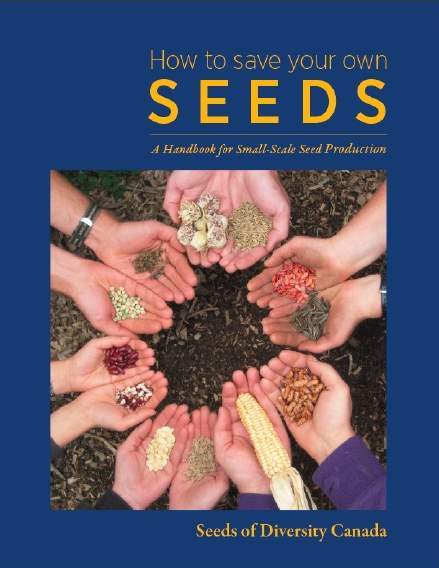How to Save Your Own Seeds

A Handbook for Small-Scale Seed Production
Check out the brand new, updated and expanded edition of Seeds of Diversity's popular seed saving guide!
Our popular seed-saving handbook is greatly expanded (to 68 pages) from the previous edition, giving seed savers the most up-to-date information on seeds, flowers, and pollination. It demystifies the techniques of saving seeds from common garden vegetables, giving simple detailed instructions for each type.
Written with beginners and experts in mind, this is a manual for home seed savers as well as small-scale commercial growers. Whether you are learning to save rare heirloom varieties, discovering how to save money by growing your own seeds, or simply interested in learning more about the finer aspects of seeds and gardening, this is an excellent beginner's manual. Sections for the advanced seed saver give details on seed production of biennial crops (beets, carrots, celery, leeks, etc), hand pollination, and many more helpful hints.
- Best of new, cutting-edge research and improved techniques
- Detailed, step-by-step seed saving and storage instructions
- Beautiful illustrations and photographs
- Separate instructions for beginners and experts
- Easy-to-follow reference tables and charts for each species
- Extra features such as pollinator profiles and seed saving tips
- Clear explanations of botanical concepts
Order now for $15.00 including postage at www.seeds.ca/store
Contents:
- Why Save Seed?
- What's in a Seed?
- What's in a Flower?
- What's in a Fruit?
- Botany Basics
- Pollen and Pollinators
- Tools of the Trade
- Planning and Isolation
- Harvesting Seeds
- Cleaning Seeds
- Storing Seeds
- Overwintering Biennials
- Bean Family (including beans, peas, fava beans, lima beans, runner beans, soy beans, mung beans, chick peas, lentils)
- Beet Family (including beets, sugar beets, swiss chard, spinach)
- Cabbage Family (including cabbage, kale, broccoli, cauliflower, chinese cabbage, brussels sprouts, kohlrabi, turnip, rutabaga, mustard, radish, arugula)
- Carrot Family (including carrot, celery, celeriac, parsnip, parsley, anise, chervil, dill, fennel)
- Lettuce Family (including lettuce, endive, chicory, radiccio, salsify, sunflower, jerusalem artichoke)
- Onion Family (including onions, leeks, garlic)
- Squash Family (including summer squash, winter squash, pumpkin, cucumber, gourd, melon, watermelon)
- Tomato Family (including tomato, currant tomato, pepper, eggplant)
- Quick Reference Guide (showing detailed pollination and seed storage needs of 87 species of vegetables, grains, and herbs)
For the preservation work of Seeds of Diversity to be successful, our members must know and follow proper seed saving techniques, including how to keep varieties from crossing with each other. If you are planning to save your own seeds and possibly offer them in our Member Seed Directory, we encourage you to order this handbook and learn these valuable and simple techniques.
Back to October 2013 Newsletter
|


